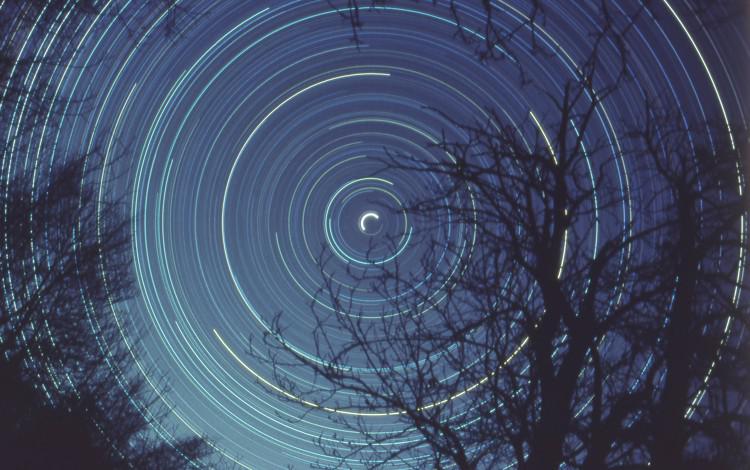This page describes an image Half day exposure to the north star, by Fabrizio Melandri, Italy
Image caption:
First place in the IAU OAE Astrophotography Contest, category Star trails.
This star trail image shows the apparent movement of the stars in the night sky, which results from the Earth’s rotation around its polar axis. The trees in the foreground serve as an anchor as we turn with the Earth. The bright white semi-circle in the center of the image is the North (Pole) star – Polaris, which is located very close to the North Celestial Pole. One way to imagine that the Earth is at center of hollow crystal sphere, and the stars are embedded on this sphere, as the Earth spins on its axis, an observer on Earth sees the stars rising and setting, following an arc, because the horizon prevents the observer from the full arc for stars that are further away from the Celestial Pole. The North Celestial Pole (and its opposite the South Celestial Pole) is essentially formed by extending the line of the Earth’s axis. Capturing this image requires the photographer to take a long exposure with the camera on a tripod and pointing towards the Pole Star (North Hemisphere). In the Southern Hemisphere there is no star as close as Polaris is to the Celestial Pole, so the position of the South Celestial Pole is found using the South Cross and Pointer Stars (Alpha and Beta Centauri). Although overall the image has a slight blue tint, it does capture the varying colours of stars, it is easy to distinguish between the higher temperature blue stars and the lower temperature of the whitish stars, and even lower temperature reddish stars. The reason for this variation in colour is because higher temperature stars emit more in shorter wavelengths (bluer), compared to lower temperature stars which emit in longer wavelengths (redder).
Scroll to captions in other languages
Image credit:
Fabrizio Melandri/IAU OAE
DOI: 10.5281/zenodo.5371231
Related glossary terms:
Circumpolar Stars
, Star Trail
Image license: Creative Commons Attribution 4.0 International (CC BY 4.0) Creative Commons Attribution 4.0 International (CC BY 4.0) icons
The media file captions presented on the OAE website were written, translated and reviewed by a collective effort from the OAE, the OAE Centers and Nodes, the OAE National Astronomy Education Coordinators (NAECs) and other volunteers. You can find a full list of credits for our translation project here. All media file captions are released under a Creative Commons CC BY-4.0 license and should be credited to "IAU OAE". The media files themselves may have different licenses (see above) and should be credited as listed above under "credit".
Captions in Different Languages:
Image caption: Premier prix du concours d'astrophotographie de l'UAI OAE, catégorie Traînées d'étoiles.
Cette image de la traînée d'étoiles montre le mouvement apparent des étoiles dans le ciel nocturne, qui résulte de la rotation de la Terre autour de son axe polaire. Les arbres au premier plan servent de point d'ancrage lorsque nous tournons avec la Terre. Le demi-cercle blanc brillant au centre de l'image est l'étoile polaire nord - Polaris, qui est située très près du Pôle Nord Céleste. On peut imaginer que la Terre est au centre d'une sphère de cristal creuse, et que les étoiles sont incrustées dans cette sphère. À mesure que la Terre tourne sur son axe, un observateur sur Terre voit les étoiles se lever et se coucher, suivant un arc, car l'horizon empêche l'observateur de voir l'arc complet pour les étoiles qui sont plus éloignées du pôle céleste. Le Pôle Céleste Nord (et son opposé le Pôle Céleste Sud) est essentiellement formé en prolongeant la ligne de l'axe de la Terre. Pour capturer cette image, le photographe doit prendre une longue exposition avec l'appareil photo sur un trépied et pointer vers l'étoile polaire (Hémisphère Nord). Dans l'Hémisphère Sud, aucune étoile n'est aussi proche du Pôle Céleste que Polaris. La position du Pôle Céleste Sud est donc déterminée à l'aide de la Croix du Sud et des étoiles pointeurs (Alpha et Beta Centauri). Bien que l'image ait une légère teinte bleue, elle capture les différentes couleurs des étoiles. Il est facile de distinguer les étoiles bleues à haute température des étoiles blanchâtres à plus basse température, et même des étoiles rougeâtres à plus basse température. Cette variation de couleur s'explique par le fait que les étoiles à température élevée émettent davantage dans des longueurs d'onde plus courtes (plus bleues) que les étoiles à température plus basse qui émettent dans des longueurs d'onde plus longues (plus rouges).
Image credit: Fabrizio Melandri/IAU OAE
Related glossary terms: La piste des étoiles , Étoiles circumpolaires Caption translation status: Not yet approved by a reviewer
Caption translators: Rulx Narcisse
Image caption: Primo posto al concorso di astrofotografia IAU OAE, categoria Scie stellari.
Questa immagine della scia stellare mostra il movimento apparente delle stelle nel cielo notturno, che deriva dalla rotazione della Terra attorno al suo asse polare. Gli alberi in primo piano fungono da ancora mentre ruotiamo con la Terra. Il luminoso semicerchio bianco al centro dell'immagine è la stella Polare, che si trova molto vicina al Polo Nord Celeste. Immaginando che la Terra sia al centro di una sfera di cristallo cava e che le stelle siano incastonate in questa sfera, mentre la Terra ruota sul suo asse, un osservatore sulla Terra vede le stelle sorgere e tramontare seguendo un arco, perché l'orizzonte impedisce all'osservatore di vedere l'arco completo delle stelle più lontane dal Polo Celeste. Il Polo Nord Celeste (e il suo opposto, il Polo Sud Celeste) si forma essenzialmente prolungando la linea dell'asse terrestre. Per catturare questa immagine è necessario che il fotografo effettui una lunga esposizione con la fotocamera su un treppiede, puntata verso la Stella Polare (Emisfero Nord). Nell'emisfero australe non c'è una stella così vicina al Polo Celeste come la stella Polare, quindi la posizione del Polo Celeste Sud viene individuata utilizzando la Croce del Sud e le stelle puntatrici (Alfa e Beta Centauri). Sebbene nel complesso l'immagine abbia una leggera sfumatura blu, essa cattura i diversi colori delle stelle; è facile distinguere tra le stelle blu a temperatura più elevata e le stelle biancastre a temperatura più bassa, e le stelle rossastre a temperatura ancora più bassa. La ragione di questa variazione di colore è che le stelle a temperatura più alta emettono maggiormente in lunghezze d'onda più corte (più blu), rispetto alle stelle a temperatura più bassa che emettono in lunghezze d'onda più lunghe (più rosse).
Image credit: Fabrizio Melandri/IAU OAE
Related glossary terms: Scia stellare , Stelle circumpolari Caption translation status: Approved by a reviewer
Caption translators: Giuliana Giobbi
Caption reviewers: Silvia Casu, Rodolfo Canestrari









